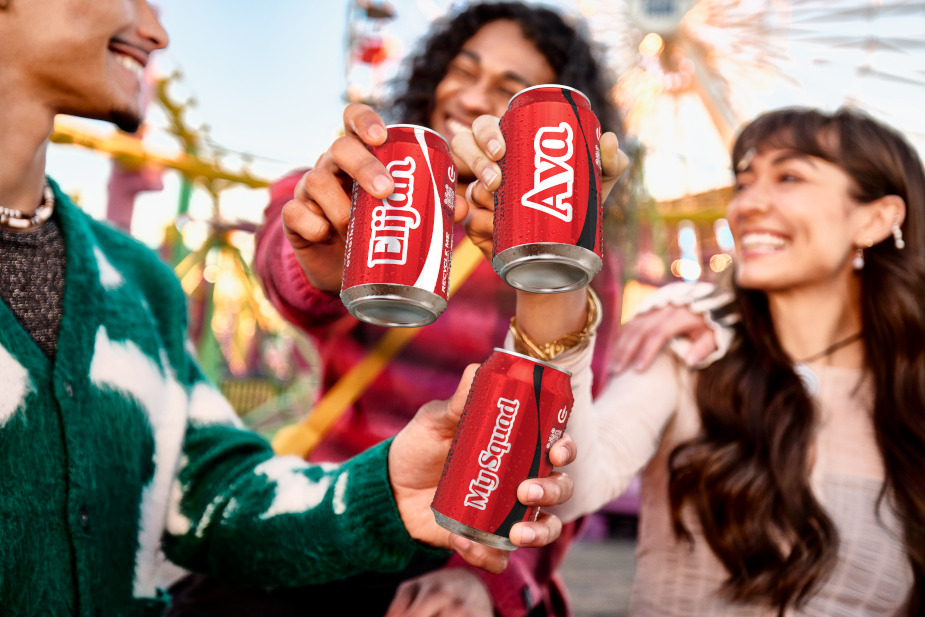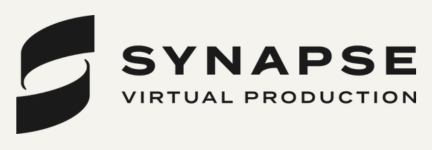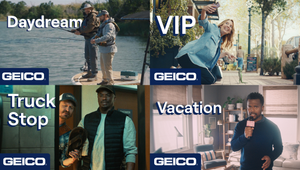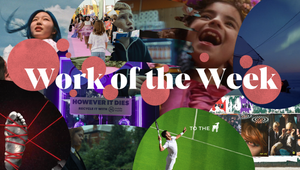
Nostalgia’s 20/20. Is It Time to Stop Looking Backwards?

Amid the constant churn of new campaigns, product launches and brand platforms, a different pattern is emerging: a resurgence of the old. Brands are tapping into nostalgic sentiment and their own histories to forge deeper emotional connections.
From Coca-Cola’s revival of ‘Share a Coke’to Hovis leaning on faded billboards to reinforce its heritage, nostalgia is being used to signal authenticity and cultural relevance.
But is this about comfort in uncertain times, or a convenient creative shortcut? And where does that leave innovation?
To unpack the power and pitfalls of nostalgia, an array of creative minds from across the globe and industry shared their thoughts with LBB’s Abi Lightfoot.
An Antidote to Uncertainty
Amidst political turmoil, economic uncertainty, environmental concerns and global instability, people are looking for reprieve from the often unrelenting stream of bad news coming in all directions.
It might come in the form of rewatching a comfort TV show over and over again, or rediscovering a lost hobby – people are craving comfort and a sense of familiarity. Brands have noticed this too, and are tapping into the draw of nostalgia as a way of capturing consumers, suggesting their products are a gateway to better.
It’s a sentiment echoed by Tim Walsh, UK head of strategy at Momentum Worldwide, UK. “Nostalgia’s dominance in brand storytelling isn’t just a trend, it’s a response to the times we’re living in,” he says. “With so much uncertainty out there, nostalgia offers something people are craving, emotional comfort. It taps into memories that feel safe, familiar and real. And for brands, that’s powerful.”
Halle Mason, senior brand strategist at Gravity Global, reflects that there’s an irony to the effectiveness of nostalgia in advertising, especially in times of uncertainty. “Nostalgia is a sentiment that – ironically, given its inherent basis in the past – stands the test of time. In times of cultural or economic uncertainty, people reach for what’s familiar; looking back can often feel safer than facing the unknown.”
Meanwhile, Christian James, managing director of creative agency IF suggests that there’s a cyclic relationship between advertisers and consumers that’s fuelling a resurgence of nostalgia. “During times of social and economic stress – lockdown, recession, war, etc. – people increasingly look to the past for a number of reasons (emotional comfort, rekindling their sense of purpose, social connection), and we in the ad industry pick up on this and exploit it (re-runs, retro, vintage). As more campaigns are shared, that in turn fuels more consumers to turn to nostalgic sentiment. And so it goes around.”
“Nostalgia doesn’t just feel nice, it feels necessary,” adds MullenLowe’s VP, group strategy director Lindsay Cardinale. “Since 2020, we’ve gone from living in a VUCA (volatile, uncertain, complex and ambiguous) to a BANI (brittle, anxious, nonlinear, and incomprehensible) era.” Therefore, nostalgia, or a deference back to ‘better’ acts as a beacon of hope and optimism – “an emotional connection to positive memories that provide a sense of stability and security, it can be a hopeful reminder that it won’t be like this forever.”
Reflecting on its emotional impact, Jessica Hoffeldt, associate account director at Agnostic, highlights nostalgia’s unique ability to cut through logic and create deeper audience resonance. “[Nostalgia] has the ability to bypass logic and tap directly into human emotion, memory and identity,” she says. “As we find ourselves in increasingly uncertain economic, political and social times, the desire to look backwards to simpler days will only continue to grow. When the world feels chaotic people reach for the past.”
However, whilst reaching for the past might act as a comfort blanket, Keith Muir, senior strategist at Born Social warns of the dangers of using nostalgia as a creative “shield” that harks back to a safer, more reassuring time, and forgets that the technique can also pave the way for storytelling that’s progressive in nature.
“It’s time to stop looking back at appropriate nostalgia as a replacement for originality,” says Keith. “It’s time to intentionally harness the best of what’s come before for the sake of progression. If history’s destined to repeat itself, we may as well use its best bits.”
A Creative Shortcut or a Tool?
Is resorting to nostalgia as a marketing tactic simply taking a creative shortcut? For Stuart Parker, head of business development at Collaborate Global, it’s a risk that brands grapple with if they’re ‘careless’ in how they use nostalgia and forget to look ahead whilst looking back.
“Nostalgia has an undeniable pull,” he explains. “It taps into deep emotional currents, comfort, connection and belonging - invaluable for brands seeking relevance in uncertain times. But when wielded carelessly, nostalgia risks becoming a shortcut: a glossy rerun blocking true creative progress.
Lauren Castagni Mote, founder at advertising agency Sage7, agrees. She says that if nostalgia is used as a “crutch”, it implies that a brand doesn’t truly know, or understand its audience.
To counteract this, brands that want to embed references to the past in their marketing should only do so with present day consumers – and the future – in mind. “The best use of nostalgia isn’t about replicating the past, it’s about reframing it,” says Lauren. “Remixing, recontextualising and making it speak to now. When done right, it builds emotional resonance and brand distinctiveness. When done lazily, it’s just a comfort blanket. I don’t think we need to ditch nostalgia as a device. But we do need to stop mistaking fond memories for meaningful connection.”
VIRTUE Worldwide’s group creative director Nari Kim argues that nostalgia is “hardwired into us” as people – however it's the proximity from an era that allows us to truly feel nostalgia towards it. “It takes time and distance to truly recognise what defined an era, and only in hindsight can we start to appreciate it. In a way, nostalgia is just us saying, ‘Hey, that actually meant something.’”
She adds that nostalgia in its current form “makes sense” – amidst tech and trends that change rapidly, people are craving familiarity. “But at the end of the day, it’s not whether we use nostalgia – it’s how and why,” says Nari. “It’s just one storytelling tool in the box, and like any tool, it works best when it’s right for the job.”
In a similar vein, AJ Gutierrez, ECD at Superbloom says that it’s “impossible to escape” nostalgia. “Whether we like it or not, it influences all of our work, no matter how original it may seem.” Therefore, for AJ, brands and advertisers must use this inevitability to their advantage, using nostalgia not as a “creative shortcut,” but as “a tool to help develop creative work that aligns with the present-day culture.”
Why not Both?
So, can nostalgia be both a creative shortcut and strategic tool? Marla Moore, head of strategy at BUCK, thinks so.
“Is nostalgia a creative shortcut or a strategic tool? Why can’t it be both?” she ponders. “When applied properly, nostalgia quickly taps into a known mindset and immediate emotional response, both of which comprise most of what brand campaigns aim to do daily. However, if nostalgia is threaded into creative that doesn’t make sense, that shortcut can backfire, alienating consumers who see its use as a cheap trick by brands to ingratiate themselves.”
Marla adds that the role of nostalgia in modern advertising will “flex and flow” as times and trends change. “Nostalgia in marketing will span a spectrum to meet the needs of the message at hand, and it's up to the creatives and strategists employing it to determine whether it strikes the yearning of true nostalgia for the past or brings forward the FOMO of ‘new-stalgia’ today.”
Both Marla and Suzy Mae Mattay, strategy director at Battery, noted a rise in ‘anemoia’ amongst consumers, a sensation similar to nostalgia that evokes feelings of comfort and familiarity.
“Today, when the US is experiencing insecurity and a lack of trust, nostalgia and anemoia bring us to places of comfort,” Suzy explains, “The ‘sentimental longing’ of nostalgia isn’t limited to folks who have lived through a certain moment. Anemoia describes a longing for a time or place never experienced before. Both these states are powerful emotional tools, highly useful for strategic application and creative curation.”
“Personally, I don’t think we can lean on nostalgia enough in advertising and wider marketing. It’s a tool in the toolbox that never loses its edge, never dulls when wielded in the right way,” says Matt Buttrick, head of brand strategy at Bountiful Cow. He explains that nostalgia, and even ‘fauxtalgia’, “the idea that we can yearn for times, objects and places we never even lived through,” hold significant weight in advertising, with a timeless “allure” that has the potential to draw people in, and ensure they keep coming back – take Coca-Cola’s ‘Holiday’s Are Coming’ jingle and accompanying red truck, for example.
“When done well, nostalgia can signal that a brand values its audience enough to connect in a way that makes them feel relevant and celebrated,” adds Glen Hilzinger, partner and CCO at Luquire, suggesting that nostalgia’s power can be built up through relevancy, but quickly stripped back by overuse or pigeonholing, it’s a ‘tool’ that must be wielded with caution and efficiency. “As with any other storytelling device, nostalgia is neither inherently good or bad. It’s just another tool in the creative toolbelt.”
Rooted in Relevance
For nostalgia to truly make an impact in 2025, it must be rooted in 2025. Whether it’s revitalising an idea from five years or two decades ago, brands need to take note of present day circumstances and conversations, finding ways to reintroduce ideas from the past in a way that feels fresh and exciting, rather than stale or out of date.
Alex Marks, head of marketing at out of home agency Posterscope considers generational differences and experiences when offering his view on nostalgia.“What’s ‘nostalgia’ for me is something new and creative for my children, who have grown up being fed their culture down a pipe. It’s no surprise that the resurgent interest in vinyl, DVDs, and shopping in person is being driven by the under 25s.”
Consumers, therefore, are looking beyond the algorithm to find creative that really resonates, choosing to go back to ‘nostalgic’ ways of consuming media that haven’t been delivered by a data-fed algorithm.
For Jonathan Izzard, head of strategy at Wonder (part of the Amplify collective), nostalgia is all relative. “At a macro level certain things resonate across the board, but even those are skewed, either generationally or geographically. Then you get into the minutia of memories: identical moments might be spine-tingling for one person but shudder-inducing for another. It’s no one thing. And whilst nostalgia is a notion to which everyone can in some way relate, we’re also all a product of the road we’ve individually travelled.”
Therefore, the value of nostalgia for Jonathan boils down to three things: legitimacy, originality and delivery. “The few brands that have a credible cross-generational connection (the likes of Heinz, Nike, McDonald’s, Nintendo and more) tend to leverage nostalgia authentically, if perhaps, at times, rather liberally,” he says. “For the rest of the world, I personally don’t mind a brand leaning into this territory as long as the insight is solid and the creative’s strong.”
Brands must be intentional, using nostalgia as a vehicle to move things forward and engage with new audiences, rather than trapping a brand in the past, says Tim from Momentum. “People can spot lazy nostalgia a mile off. But when brands use it to open new conversations, spark real emotion and create something fresh, that’s when it really works.”
Psembi Kinstan, chief creative officer at DDB Melbourne agrees, “I’ll differentiate between brand ‘nostalgia’ that’s lazy and just copies old trends unnecessarily, and the ‘nostalgia’ of tapping into ideas or themes that have been part of a brand’s DNA. You can’t overdo the latter. Interesting memory structures and big brand ideas that last for decades are brilliant. And successful. We should all be celebrating these more.
“Ads that are nostalgic for the sake of it however, unless it’s an anniversary campaign, or using nostalgia for a reason, are mostly rubbish. Avoid these at all costs.”
“I do think there's a mental desire for nostalgia, generally, from people,” says Olly Taylor, CSO at Havas Creative Group, Australia, because it's comforting. But then I do think there's another theme of brands and businesses manufacturing it to a degree because it's tried and tested and has worked.”
However, he does think that it's potentially quite lazy. “At its best, it connects you to a great time and makes people feel an emotional sense of well being. And I think at its worst, it feels, from a brand perspective, like a brand hasn't or can't move on and is stuck in a previous era. There are obviously benefits and negativity to both of those outcomes.”
Sharing an optimistic view on the role of nostalgia, Audelino Moreno, associate creative director at Mythic says, “Looking back isn’t merely about aesthetics or sentimentality. It’s a way to reflect on how we’ve navigated unpredictability before – and how we’ll do it again, which feels relevant in the age of AI. Nostalgia, at its best, doesn’t trap us in the past; it reminds us that we’ve always lived with uncertainty, and we’ve always found a way forward.”
Managing director of IF, Christian James, believes the most effective uses of nostalgia come when a brand revisits an old story but adds a “twist,” helping to ground the brand in the present, whilst reminiscing core moments in a brand’s story simultaneously. “Take the re-boot of Coca-Cola’s ‘Share a Coke’ campaign,” he says. “Squarely aimed at gen Z, it was re-released this year after 12 years, but with the addition of the innovative ‘Coke Memory Maker’, allowing users to create personalised memes and videos, blending nostalgia with modern digital engagement to appeal to a broader audience.”
For Divyanshu Bhadoria, chief strategy officer at Toaster INSEA, much of today’s so-called nostalgia feels like a hollow revival—bringing back the look of the past, but none of the meaning.“What we see in advertising, design, and the creative industries is not nostalgia. It can be more accurately described as the zombiefication of the past - where we resurrect the form of the past, but not its feeling.
“Similarly in advertising, especially in India, we see a lot of throwback celebs, jingles and designs making a comeback. But here again, the motivation is the trend-frenzied PR-ability of these moves. To build a sustainable meaning or memory structure for the brand, is neither the ambition, nor the impact.” He suggests that in using nostalgia, brands are looking for short-term PR ‘wins’ and are neglecting to think of more fruitful, brand building exercises.

Progressive vs Sentimental
“Nostalgia is always such a guilty pleasure.,” says Kristian Andrews, creative director at Studio AKA. However, it’s one that must be tempered. “As tempting as it is to long for the past, we can't deny the future. There's just so much to revel in right now, from engaging with new generations and discovering new platforms for our work; not to mention mastering new tools.”
The pace of technology means that there’s little time to spend absorbed in the past, and instead the animation studio must keep itself working at the rate of change. “For us, the goal in this brave new world is to forge unique ways of engaging with these new tools,” says Kristian, “with a heart full of nostalgia for our craft and a voice that's distinct and full of idiosyncratic personality; that’s how we'd like to move the conversation forward.”
Michelle Milner, insight director at the7stars, adds that for brands to truly move the conversation forward, they need to position themselves as “a credible voice of hope and optimism.” This might be a difficult tone to strike amidst political and economic uncertainties, but there are rewards to be reaped for brands that do it right. Brands that show the same resilience their audiences do are more likely to win hearts than those who avoid the future by retreating to ‘easier’ times in the past.
“Brands should therefore find reasons to look forward,” says Michelle. “To embrace what’s next and connect with cultural occasions that spark excitement and anticipation. The rose-tinted glasses can go back in the drawer.”
Susan Golkin, ECD at VML, suggests that there’s a choice to be made in determining the ideas that are revisited, versus those that are left in the past. Brands can find value and new audiences by reworking concepts and characters, but it has to be done with integrity and intention. “It’s no secret that looking backwards feels a lot easier than looking forward. Forward is too scary right now. But easier doesn’t mean safer. One woman’s nostalgia is another woman’s brand new. New generations get exposed to great and meaningful cultural ideas when we dust them off and refresh them for a second round.
“Take ‘When Harry Met Sally’ for Hellmann’s. The campaign didn’t just sell a lot of mayo, it ignited and reignited interest in the movie. Downloads of the movie have tripled, and screenings are popping up at small theaters all over the country. Billy and Meg gave the Best Picture Award at this year’s Oscars. Not everything needs to come back, however. I have some Gunne Sax dresses that never need to see the light of day again, but what’s good and relatable should never be put on the shelf.”
Eryn LeMesurier, group strategy director at Leo Australia, warns of the challenges that come alongside nostalgia. Firstly:overuse can dilute impact. “Our industry is built on creativity and launching ideas that are new, not recycled. Novelty is what cuts through, and the more remakes we see, the less power nostalgia holds.”
Secondly, brands need to consolidate their role within today’s market, and by always looking back, they risk appearing oblivious. “Many of today’s most influential brands are also looking to redefine their relevance in a disrupted landscape, for a new generation. A simple return to the past won’t move them forward. And lastly, nostalgia can romanticise a past that didn’t exist, which actually excluded and marginalised entire communities.”
“So, where do we go from here?” ponders Eryn. “I’d argue the answer isn’t to borrow from the past, it’s to reinvent it. Whether it’s Barbie or Beyoncé, the most powerful cultural reinventions don’t just copy the past. They reclaim it, subvert it, and make it more inclusive. Brands like Old Spice and Lego show us the blueprint of how to use the past to give a brand a new place in the present. They use nostalgia as an ingredient to launch a brand forward, redefine a category, and even push culture ahead. That’s where nostalgia holds potential: not in repurposing the past, but in using it as fuel for reinvention.”















